Evaluation of Hot Pressing Processing by Physical Properties of Ecofriendly Composites Reinforced by Eucalyptus Sawdust and Chamotte Residues
Abstract
:1. Introduction
2. Materials and Methods
2.1. Raw Materials
2.2. Panels Manufacture
2.3. Testing Performed
3. Results and Discussions
Scanning Electron Microscopy
4. Conclusions
Author Contributions
Funding
Conflicts of Interest
References
- FAOSTAT. Particleboard Production Quantity in World and Brazil. Available online: http://www.fao.org/faostat/en/#data/FO/visualize (accessed on 4 January 2023).
- Auriga, R.; Auriga, A.; Borysiuk, P.; Wilkowski, J.; Fornalczyk, O.; Ochmian, I. Lignocellulosic Biomass from Grapevines as Raw Material for Particleboard Production. Polymers 2022, 14, 2483. [Google Scholar] [CrossRef]
- Lee, S.H.; Lum, W.C.; Boon, J.G.; Kristak, L.; Antov, P.; Pędzik, M.; Rogoziński, T.; Taghiyari, H.R.; Lubis, M.A.R.; Fatriasari, W.; et al. Particleboard from agricultural biomass and recycled wood waste: A review. JMRT 2022, 20, 4630–4658. [Google Scholar] [CrossRef]
- Dionizio, A.F.; Vale, A.T.; Moreira, A.C.O.; Galvão, L.G.O.; Chaves, B.S.; Costa, M.A. Adding value to agro-industrial waste for energy purposes. Rev. De CiÊNcias AgrÁRias 2019, 42, 528–538. [Google Scholar] [CrossRef]
- Pędzik, M.; Janiszewska, D.; Rogoziński, T. Alternative lignocellulosic raw materials in particleboard production: A review. Ind. Crops Prod. 2021, 174, 114162. [Google Scholar] [CrossRef]
- Klímek, P.; Wimmer, R.; Meinlschmidt, P.; Kúdela, J. Utilizing Miscanthus stalks as raw material for particleboards. Ind. Crops Prod. 2018, 111, 270–276. [Google Scholar] [CrossRef]
- Paula, L.E.R.; Trugilho, P.F.; Napoli, A.; Bianchi, M.L. Characterization of residues from plant biomass for use in energy generation. Cerne 2011, 17, 237–246. [Google Scholar] [CrossRef]
- Oliveira, J.N., Jr.; Lopes, F.P.D.; Simonassi, N.T.; Souza, D.; Monteiro, S.N.; Vieira, C.M.F. Evaluation of the physical properties of composite panels with eucalyptus sawdust waste and castor oil-based polyurethane. JMRT 2023, 23, 1084–1093. [Google Scholar] [CrossRef]
- Marchi, B.Z.; Oliveira, M.S.; Bezerra, W.B.A.; Sousa, T.G.; Candido, V.S.; Silva, A.C.R.; Monteiro, S.N. Ubim Fiber (Geonoma baculífera): A Less Known Brazilian Amazon Natural Fiber for Engineering Applications. Sustainability 2022, 14, 421. [Google Scholar] [CrossRef]
- Ribeiro, M.M.; Pinheiro, M.A.; Rodrigues, J.S.; Ramos, R.P.B.; Corrêa, A.C.; Monteiro, S.N.; Silva, A.C.R.; Candido, V.S. Comparison of Young’s Modulus of Continuous and Aligned Lignocellulosic Jute and Mallow Fibers Reinforced Polyester Composites Determined Both Experimentally and from Theoretical Prediction Models. Polymers 2022, 14, 401. [Google Scholar] [CrossRef]
- Oliveira Filho, E.G.; Luz, F.S.; Fujiyama, R.T.; Silva, A.C.R.; Candido, V.S.; Monteiro, S.N. Effect of Chemical Treatment and Length of Raffia Fiber (Raphia vinifera) on Mechanical Stiffening of Polyester Composites. Polymers 2020, 12, 2899. [Google Scholar] [CrossRef] [PubMed]
- Ribeiro, D.P.; Vilela, A.P.; Silva, D.W.; Napoli, A.; Mendes, R.F. Effect of Heat Treatment on the Properties of Sugarcane Bagasse Medium Density Particleboard (MDP) Panels. Waste Biomass Valorization 2019, 11, 6429–6441. [Google Scholar] [CrossRef]
- Vieira, C.M.F.; Holanda, J.N.F.; Pinatti, D.G. Caracterização de massa cerâmica vermelha utilizada na fabricação de tijolos na região de Campos dos Goytacazes—RJ. Cerâmica 2000, 46, 14–17. [Google Scholar] [CrossRef]
- Vieira, C.M.F.; Souza, E.T.A.; Monteiro, S.N. Efeito da incorporação de chamote no processamento e microestrutura de cerâmica vermelha. Cerâmica 2004, 50, 254–260. [Google Scholar] [CrossRef]
- Silva, D.W.; Farrapo, C.L.; Ribeiro, D.P.; Mendes, R.F.; Mendes, L.M.; Scolforo, J.R.S. MDP com partículas de eucalipto e palha de milho. Sci. For. 2015, 43, 853–862. [Google Scholar] [CrossRef]
- Valle, A.C.M.; Ferreira, B.S.; Prates, G.A.; Goveia, D.; Campos, C.I. Physical and mechanical properties of particleboard from eucalyptus grandis produced by urea formaldehyde resin with SiO2 nanoparticles. Eng. AgrÍCola 2020, 40, 289–293. [Google Scholar] [CrossRef]
- Morais, W.W.C.; Haselein, C.R.; Susin, F.; Vivian, M.A.; Souza, J.T. Uso de Bambusa tuldoides e Eucalyptus grandis para confecção de painéis aglomerados. CiÊNcia Florest. 2018, 28, 746–757. [Google Scholar] [CrossRef]
- Mendes, R.F.; Mendes, L.M.; Guimarães Júnior, J.B.; Mori, F.A.; César, A.A.S. Efeito da incorporação de casca de café nas propriedades físico-mecânicas de painéis aglomerados de Eucalyptus urophylla S.T. Blake. CiÊNcia E Agrotecnol. 2010, 4, 610–617. [Google Scholar] [CrossRef]
- Silva, V.U.; Nascimento, M.F.; Oliveira, P.R.; Panzera, T.H.; Rezende, M.O.; Silva, D.A.L.; Aquino, V.B.M.; Lahr, F.A.R.; Christoforo, A.L. Circular vs. linear economy of building materials: A case study for particleboards made of recycled wood and biopolymer vs. conventional particleboards. Constr. Build. Mater. 2021, 285, 122906. [Google Scholar] [CrossRef]
- Ghani, A.; Ashaari, Z.; Bawon, P.; Lee, S.H. Reducing formaldehyde emission of urea formaldehyde-bonded particleboard by addition of amines as formaldehyde scavenger. Build. Environ. 2018, 142, 188–194. [Google Scholar] [CrossRef]
- Wechsler-Pizarro, A.; Nðñez-Decap, M. Preliminary study of particleboards manufactured with pine cones and Eucalyptus globulus capsules with a bio-based polyurethane adhesive. Polym. Compos. 2022, 43, 8239–8249. [Google Scholar] [CrossRef]
- Bispo, R.A.; Trevisan, M.F.; Silva, S.A.M.; Aquino, V.B.M.; Saraiva, R.L.P.; Arroyo, F.N.; Molina, J.C.; Chahud, E.; Branco, L.A.M.N.; Panzera, T.H. Production and evaluation of particleboards made of coconut fibers, pine, and eucalyptus using bicomponent polyurethane-castor oil resin. Bioresources 2022, 17, 3944–3951. [Google Scholar] [CrossRef]
- Sugahara, E.S.; Silva, S.A.M.; Buzo, A.L.S.C.; Campos, C.I.; Morales, E.A.M.; Ferreira, B.S.; Azambuja, M.A.; Lahr, F.A.R.; Christoforo, A.L. High-density particleboard made from agro-industrial waste and different adhesives. Bioresources 2019, 14, 5162–5170. [Google Scholar] [CrossRef]
- BS EN 323; Wood-Based Panels—Determination of Density. European Committee for Standardization: Plzen, Czech Republic, 1993.
- BS EN 322; Wood-Based Panels—Determination of Moisture Content. European Committee for Standardization: Plzen, Czech Republic, 1993.
- BS EN 317; Wood-Based Panels—Determination of Swelling in Thickness after Immersion in Water. European Committee for Standardization: Plzen, Czech Republic, 1993.
- NBR 14810-2; Painéis de Partículas de Média Densidade—Parte 2: Requisitos e Métodos de Ensaio. ABNT: Rio de Janeiro, Brazil, 2018; p. 71.
- Buzo, A.L.S.C.; Sugahara, E.S.; Silva, S.A.M.; Morales, E.A.M.; Azambuja, M.A. Painéis de pínus e bagaço de cana empregando-se dois adesivos para uso na construção civil. Ambiente ConstruÍDo 2019, 19, 183–193. [Google Scholar] [CrossRef]
- Santos, W.L.F.; Silva, A.J.P.; Cabral, A.A.; Mercury, J.M.R. Particleboard manufactured from Tauari (Couratari oblongifolia) wood waste using castor oil based polyurethane resin. Mater. Res. 2014, 17, 657–663. [Google Scholar] [CrossRef]
- NBR 14810-1; Painéis de Partículas de Média Densidade—Parte 1: Terminologia. ABNT: Rio de Janeiro, Brazil, 2013; p. 5.
- Wechsler, A.; Zaharia, M.; Crosky, A.; Jones, H.; Ramírez, M.; Ballerini, A.; Nuñez, M.; Sahajwalla, V. Macadamia (Macadamia integrifolia) shell and castor (Rícinos communis) oil based sustainable particleboard: A comparison of its properties with conventional wood based particleboard. Mater. Des. 2013, 50, 117–123. [Google Scholar] [CrossRef]
- Bertolini, M.S.; Morais, C.A.G.; Lahr, F.A.R.; Freire, R.T.S.; Panzera, T.H.; Christoforo, A.L. Particleboards from CCB-Treated Pinus sp. Wastes and Castor Oil Resin: Morphology analyses and physical-mechanical properties. J. Mater. Civ. Eng. 2019, 31, 05019003. [Google Scholar] [CrossRef]
- Mesquita, A.L.; Barrero, N.G.; Fiorelli, J.; Christoforo, A.L.; Faria, L.J.G.; Lahr, F.A.R. Eco-particleboard manufactured from chemically treated fibrous vascular tissue of acai (Euterpe oleracea Mart) Fruit: A new alternative for the particleboard industry with its potential application in civil construction and furniture. Ind. Crops Prod. 2018, 112, 644–651. [Google Scholar] [CrossRef]
- EN 312; Particleboards—Specifications. European Committee for Standardization: Plzen, Czech Republic, 2010; p. 18.
- Lopez, Y.M.; Gonçalves, F.G.; Paes, J.B.; Gustave, D.; Segundinho, P.G.A.; Latorraca, J.V.F.; Nantet, A.C.T.; Suuchi, M.A. Relationship between internal bond properties and x-ray densitometry of wood plastic composite. Compos. Part B Eng. 2021, 204, 108477. [Google Scholar] [CrossRef]
- Martins, R.S.F.; Gonçalves, F.G.; Segundinho, P.G.A.; Lelis, R.C.C.; Paes, J.B.; Lopez, Y.M.; Chaves, I.L.S.; Oliveira, R.G.E. Investigation of agro-industrial lignocellulosic wastes in fabrication of particleboard for construction use. J. Build. Eng. 2021, 43, 102903. [Google Scholar] [CrossRef]
- Wong, M.C.; Hendrikse, S.I.S.; Sherrell, P.C.; Ellis, A.V. Grapevine waste in sustainable hybrid particleboard production. Waste Manag. 2020, 118, 501–509. [Google Scholar] [CrossRef]

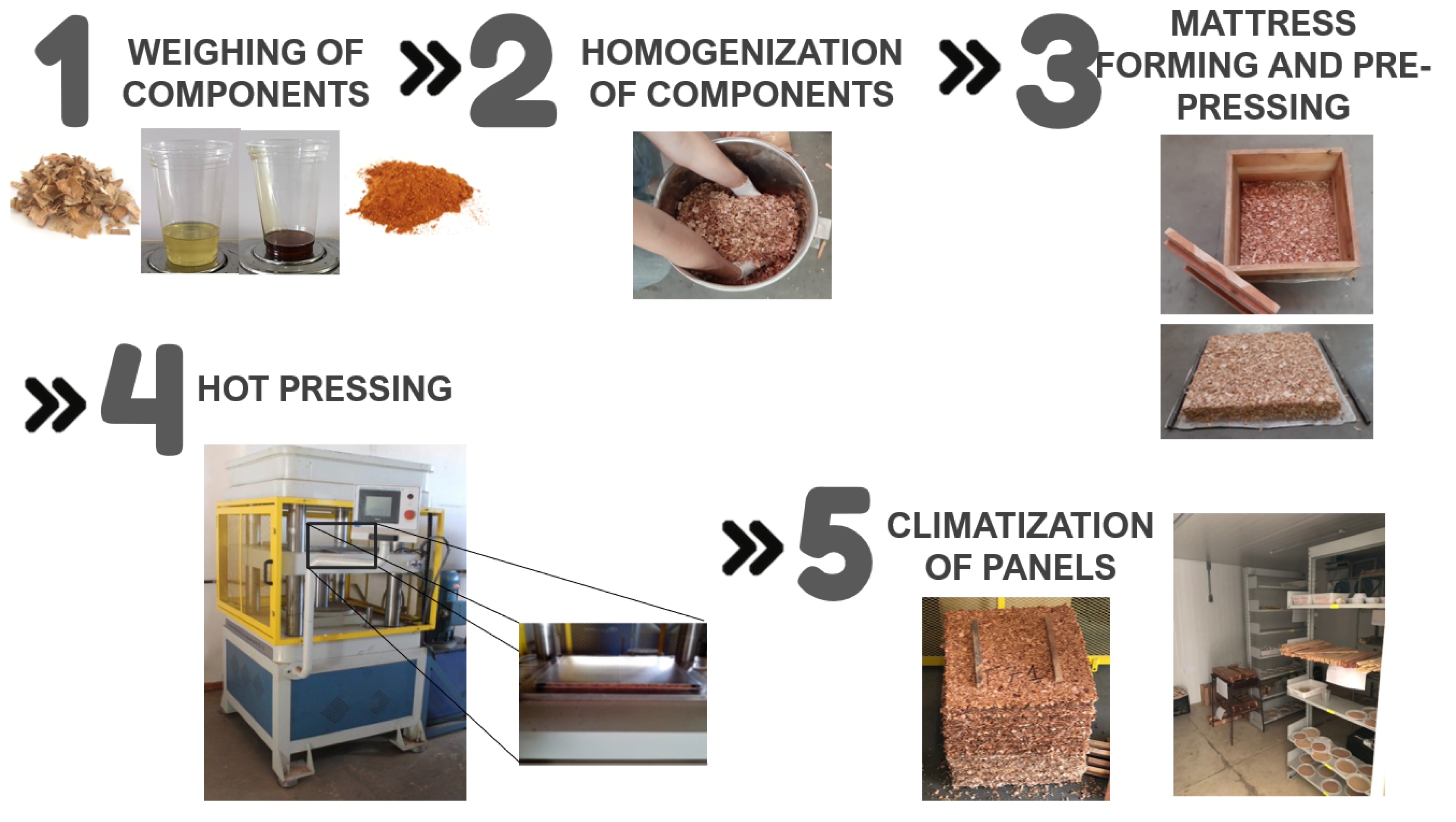

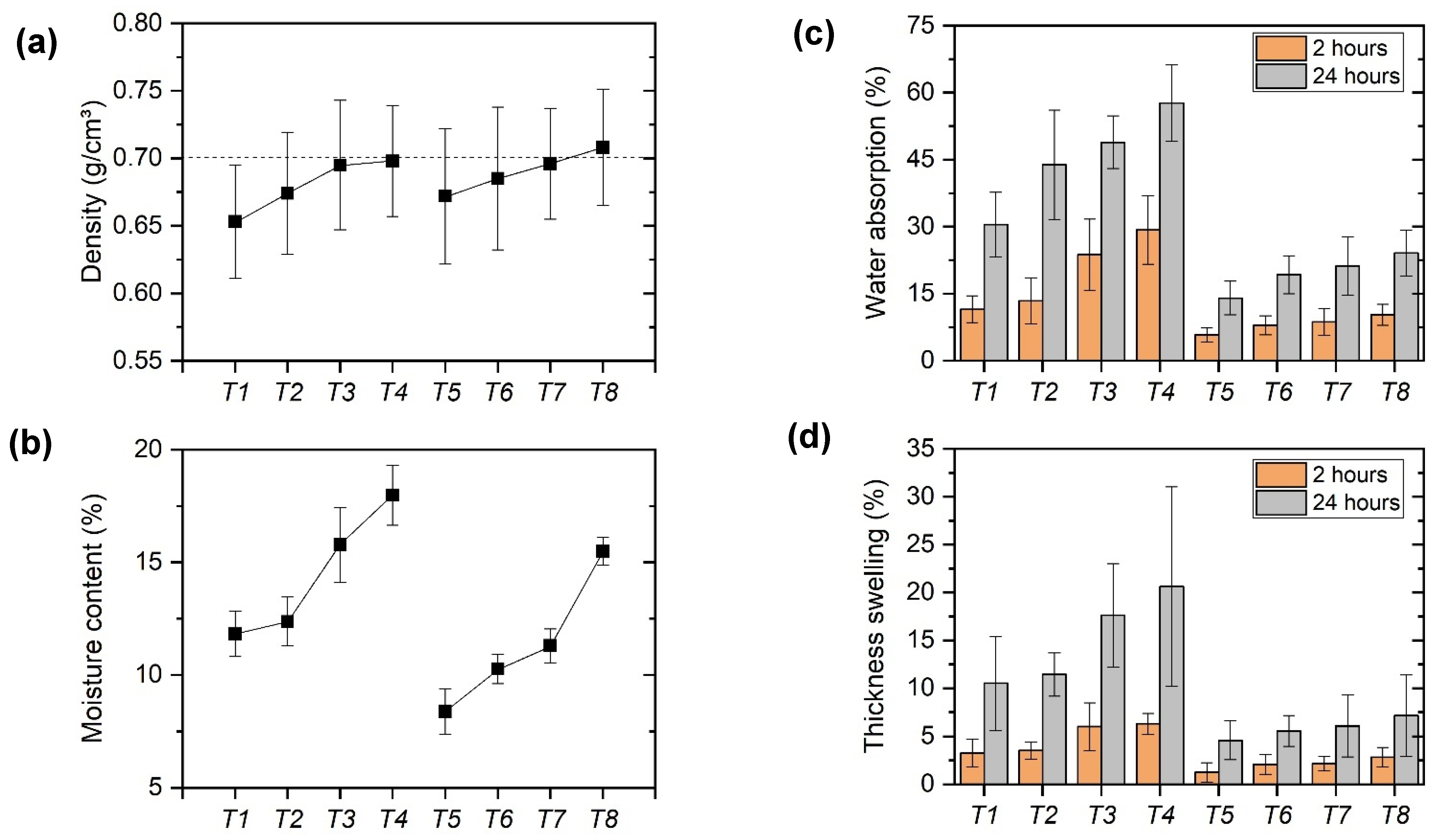
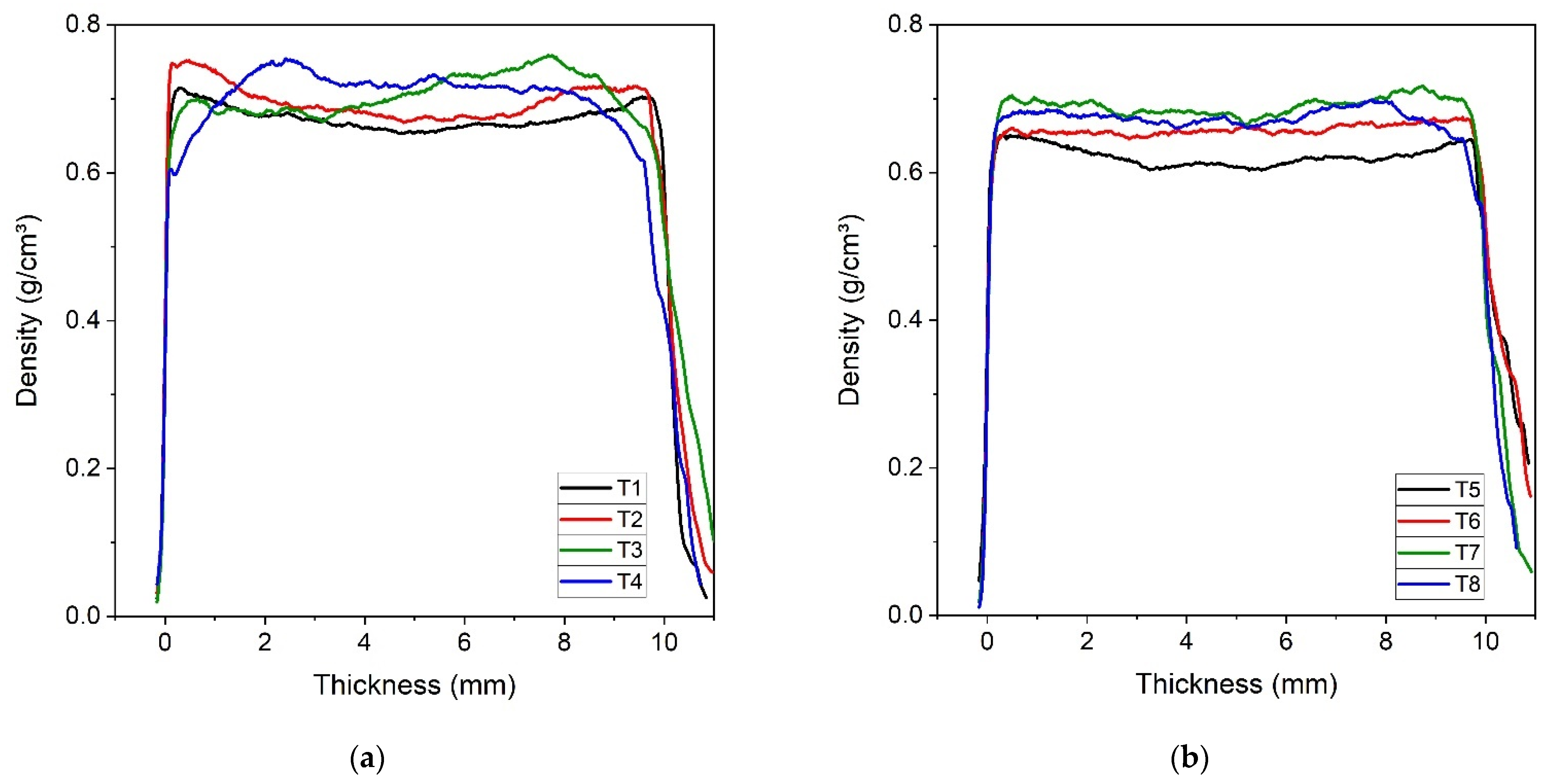
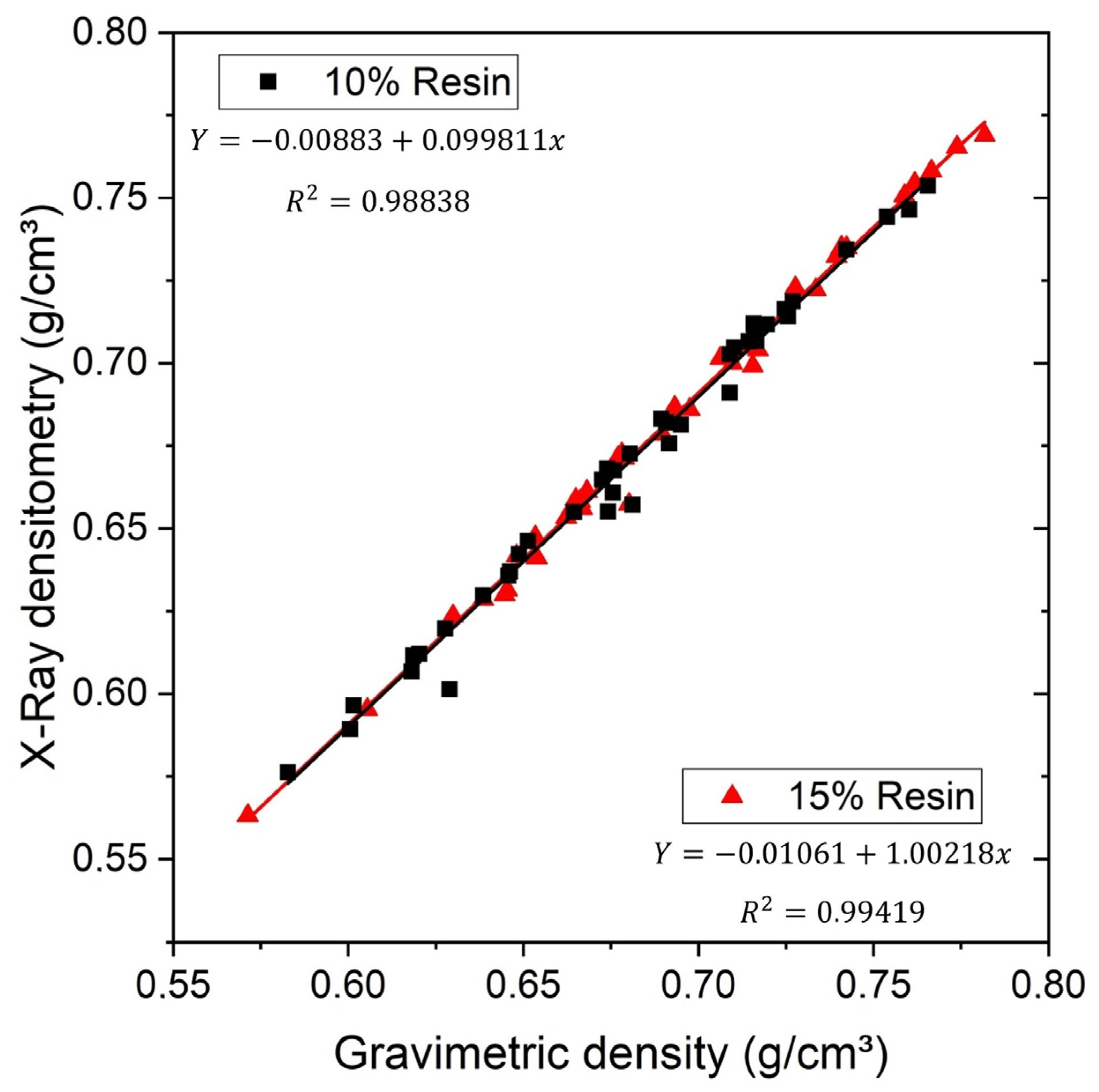
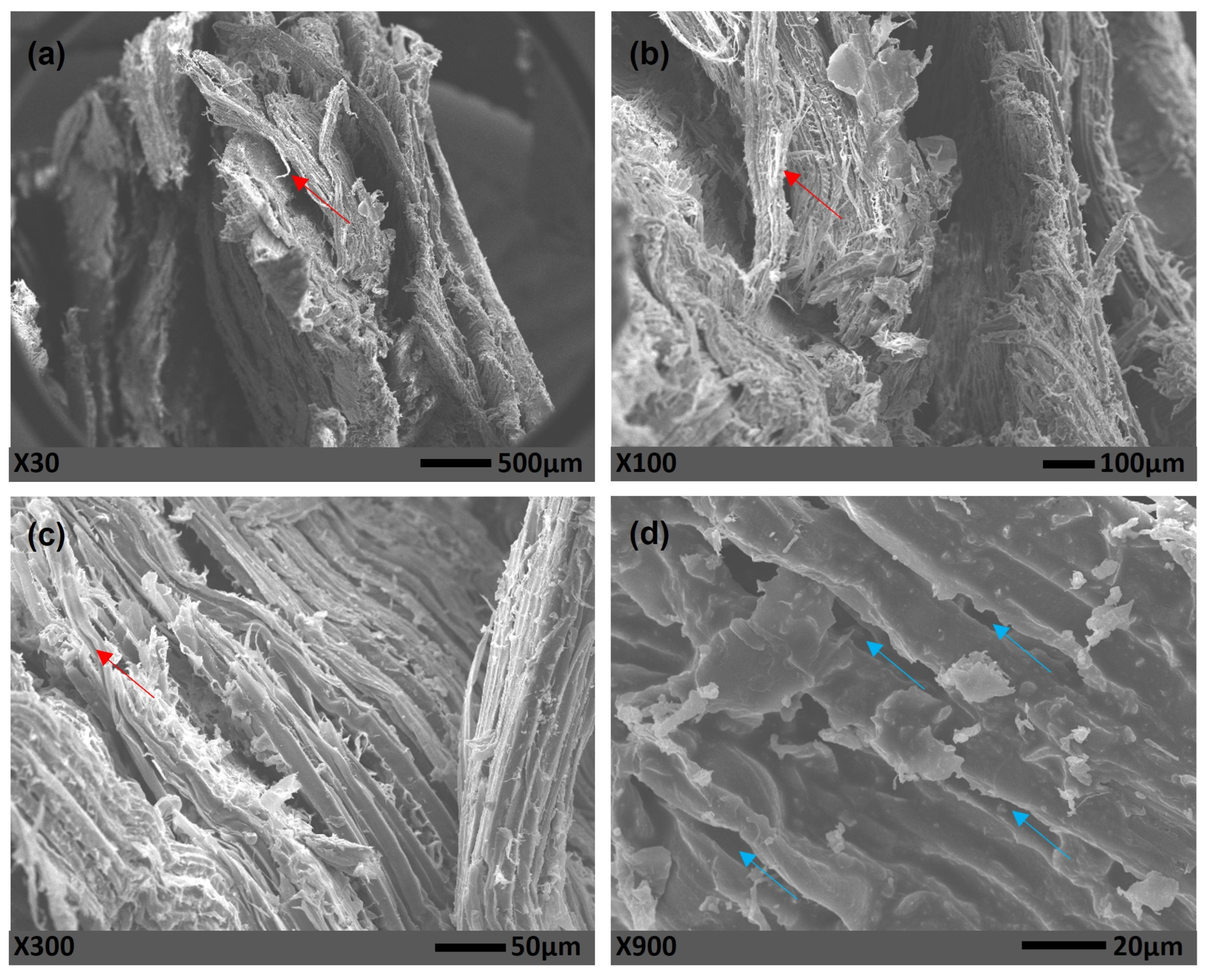

| Property | Component A | Component B | Resin |
|---|---|---|---|
| Color | Brown | Amber | Amber |
| Consistency | Liquid | Liquid | Fluid |
| Density | 1.22 g/cm3 | 0.96 g/cm3 | 1.05 g/cm3 |
| Boiling point | 330 °C | 270–290 °C | - |
| Flash point | 204 °C | 280 °C | - |
| Solubility in water | Insoluble | Insoluble | - |
| Viscosity | 170–250 mPa.s | - | - |
| Release of toxic elements | - | - | Free |
| Touch dry | - | - | 60–90 min |
| Minimum mold removal time | - | - | 6 h |
| Curing time and Handling | - | - | 24 h |
| Heat resistance | - | - | Mass loss only after 210 °C |
| Treatments | Resin (vol.%) | Chamotte (vol.%) | Eucalyptus Sawdust (vol.%) |
|---|---|---|---|
| T1 | 10 | 0 | 90 |
| T2 | 5 | 85 | |
| T3 | 10 | 80 | |
| T4 | 15 | 75 | |
| T5 | 15 | 0 | 85 |
| T6 | 5 | 80 | |
| T7 | 10 | 75 | |
| T8 | 15 | 70 |
| Treatments | Density | Moisture Content | Water Absorption | Thickness Swelling | ||
|---|---|---|---|---|---|---|
| (g/cm3) | (%) | 2 h | 24 h | 2 h | 24 h | |
| T1 | 0.653 ± 0.042 a | 11.824 ± 1.004 a | 11.501 ± 3.008 a | 30.475 ± 7.197 a | 3.261 ± 1.450 a | 10.504 ± 4.870 a |
| T2 | 0.674 ± 0.045 a | 12.369 ± 1.089 a | 13.375 ± 5.131 a | 43.839 ± 12.193 b | 3.524 ± 0.892 a | 11.441 ± 2.267 a |
| T3 | 0.695 ± 0.048 a | 15.777 ± 1.661 b | 23.696 ± 8.000 b | 48.889 ± 5.905 bc | 6.000 ± 2.475 b | 17.619 ± 5.394 ab |
| T4 | 0.698 ± 0.041 a | 17.978 ± 1.332 c | 29.271 ± 7.653 b | 57.679 ± 8.561 c | 6.293 ± 1.083 b | 20.626 ± 10.419 b |
| p-value | 0.102142 | 5.701 × 10−13 | 2.476 × 10−7 | 5.571 × 10−7 | 6.0868 × 10−5 | 0.0026298 |
| Treatments | Density | Moisture Content | Water Absorption | Thickness Swelling | ||
|---|---|---|---|---|---|---|
| (g/cm3) | (%) | 2 h | 24 h | 2 h | 24 h | |
| T5 | 0.672 ± 0.050 a | 8.371 ± 1.010 a | 5.761 ± 1.529 a | 14.020 ± 3.767 a | 1.258 ± 1.013 a | 4.577 ± 2.011 a |
| T6 | 0.685 ± 0.053 a | 10.265 ± 0.646 b | 7.931 ± 2.104 ab | 19.209 ± 4.248 ab | 2.091 ± 1.026 ab | 5.553 ± 1.580 a |
| T7 | 0.696 ± 0.041 a | 11.293 ± 0.745 c | 8.678 ± 3.027 b | 21.123 ± 6.526 b | 2.143 ± 0.738 ab | 6.084 ± 3.216 a |
| T8 | 0.708 ± 0.043 a | 15.489 ± 0.613 d | 10.278 ± 2.367 b | 24.081 ± 5.174 b | 2.844 ± 0.996 b | 7.138 ± 4.253 a |
| p-value | 0.387058 | 1.523 × 10−20 | 0.001208 | 0.0007591 | 0.007524 | 0.28783 |
| Density | Moisture Content | WA2h | WA24h | TS2h | TS24h | |
|---|---|---|---|---|---|---|
| Density | 1 | 0.5870729 * | 0.333546 | 0.178303 | 0.297361 | 0.194244 |
| Moisture Content | - | 1 | 0.862667 * | 0.804616 * | 0.876088 * | 0.825234 * |
| WA2h | - | - | 1 | 0.943514 * | 0.982379 * | 0.985754 * |
| WA24h | - | - | - | 1 | 0.954389 * | 0.971426 * |
| TS2h | - | - | - | - | 1 | 0.986341 * |
| TS24h | - | - | - | - | - | 1 |
| Treatments | Panels Apparent Density (g/cm3) by X-ray Densitometry | Average Gravimetry (g/cm3) | ||
|---|---|---|---|---|
| Average | Maximum | Minimum | ||
| T1 | 0.645 ± 0.043 | 0.708 ± 0.049 | 0.417 ± 0.092 | 0.653 ± 0.042 |
| T2 | 0.663 ± 0.047 | 0.741 ± 0.043 | 0.438 ± 0.119 | 0.674 ± 0.045 |
| T3 | 0.685 ± 0.048 | 0.766 ± 0.071 | 0.502 ± 0.066 | 0.695 ± 0.048 |
| T4 | 0.687 ± 0.042 | 0.776 ± 0.052 | 0.493 ± 0.082 | 0.698 ± 0.041 |
| T5 | 0.663 ± 0.048 | 0.657 ± 0.058 | 0.378 ± 0.069 | 0.672 ± 0.050 |
| T6 | 0.676 ± 0.054 | 0.701 ± 0.077 | 0.460 ± 0.056 | 0.685 ± 0.053 |
| T7 | 0.687 ± 0.042 | 0.739 ± 0.091 | 0.492 ± 0.124 | 0.696 ± 0.041 |
| T8 | 0.699 ± 0.044 | 0.719 ± 0.045 | 0.479 ± 0.069 | 0.708 ± 0.043 |
| Average Apparent Density | Maximum Density | Minimum Density | Gravimetry Density | |
| Average Apparent Density | 1 | 0.457009878 | 0.795819531 * | 0.997798 * |
| Maximum Density | - | 1 | 0.832633845 * | 0.484177 |
| Minimum Density | - | - | 1 | 0.796531 * |
| Gravimetry Density | - | - | - | 1 |
Disclaimer/Publisher’s Note: The statements, opinions and data contained in all publications are solely those of the individual author(s) and contributor(s) and not of MDPI and/or the editor(s). MDPI and/or the editor(s) disclaim responsibility for any injury to people or property resulting from any ideas, methods, instructions or products referred to in the content. |
© 2023 by the authors. Licensee MDPI, Basel, Switzerland. This article is an open access article distributed under the terms and conditions of the Creative Commons Attribution (CC BY) license (https://creativecommons.org/licenses/by/4.0/).
Share and Cite
de Oliveira Júnior, J.N.; Lopes, F.P.D.; Simonassi, N.T.; Oliveira, M.P.; Gonçalves, F.G.; Vieira, C.M.F. Evaluation of Hot Pressing Processing by Physical Properties of Ecofriendly Composites Reinforced by Eucalyptus Sawdust and Chamotte Residues. Polymers 2023, 15, 1931. https://doi.org/10.3390/polym15081931
de Oliveira Júnior JN, Lopes FPD, Simonassi NT, Oliveira MP, Gonçalves FG, Vieira CMF. Evaluation of Hot Pressing Processing by Physical Properties of Ecofriendly Composites Reinforced by Eucalyptus Sawdust and Chamotte Residues. Polymers. 2023; 15(8):1931. https://doi.org/10.3390/polym15081931
Chicago/Turabian Stylede Oliveira Júnior, Juvenil Nunes, Felipe Perissé Duarte Lopes, Noan Tonini Simonassi, Michel Picanço Oliveira, Fabricio Gomes Gonçalves, and Carlos Maurício Fontes Vieira. 2023. "Evaluation of Hot Pressing Processing by Physical Properties of Ecofriendly Composites Reinforced by Eucalyptus Sawdust and Chamotte Residues" Polymers 15, no. 8: 1931. https://doi.org/10.3390/polym15081931






